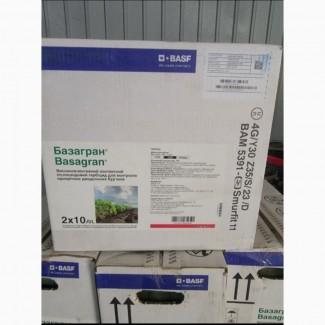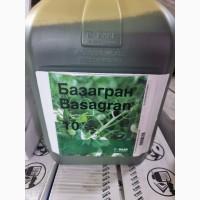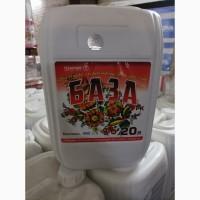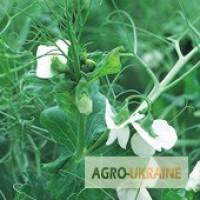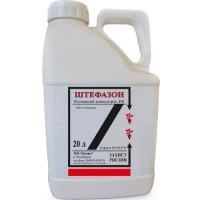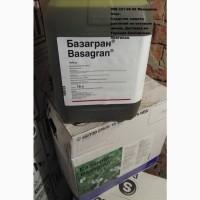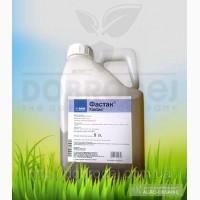For sale / buy
Bazagran is a highly selective contact post-emergence herbicide against weeds of agricultural crops, Kyiv region.
Price12$
Region:all Ukraine,
Kyiv region.
(Vyshhorodok)
Updated:
Basagran is a highly selective contact post-emergence herbicide for controlling annual dicotyledonous weeds.
Content of the active substance: 146
бентазон, 480 г/л
Preparative form:
soluble concentrate (LC)
Method of action: contact.
Consumption rate: 1.0-6.0 l/ha
The rate of consumption of the working solution: 200-400 l/ha
Warranty period of storage:
60 months at a temperature of 0...+40°C
Packaging: plastic canisters of 10 l, the price is indicated for 1 l.
Advantages of Bazagran Herbicide:
has high selectivity for cultivated plants;
no restrictions on crop rotation;
one herbicide to protect many crops;
provides increased productivity and has high economic efficiency;
in rice crops, Bazagran reliably controls not only broad-leaved weeds, but also sedge weeds;
effective canola andsunflower blight control, including Clearfield and Clearfield Plus production systems.
Application of Bazagran Herbicide:
Soya
Consumption rate - 1.5-3.0 l/ha
Spectrum of action - Annual dicotyledonous weeds.
Time of application - Spraying of crops in phase 1-3 of trifoliate leaves of the culture
Number of treatments - 1
Waiting period before entering the field (mechanized/manual work) - 3/7 days
Winter and spring wheat, rye, barley, oats
Consumption rate - 2.0-4.0 l/ha
Spectrum of action - Annual dicots, including weeds resistant to 2,4-D and 2M-4X
Time of application - Spraying of crops in the budding phase of the culture.
Number of treatments - 1
Waiting period before entering the field (mechanized/manual work) - 3/7 days
Spring cereals (wheat, barley, oats) with clover sowing
Consumption rate - 2.0-4.0 l/ha
Spectrum of action - Annual dicots, including weeds resistant to 2,4-D and 2M-4X
Time of application - Spraying of crops in the phase of the 1st trifoliate leaf in clover (in the phase of cereal bushing)
Number of treatments - 1
Waiting period before entering the field (mechanized/manual work) - 3/7 days
Millet
Consumption rate - 2.0-4.0 l/ha
Spectrum of action - Annual dicots, including weeds resistant to 2,4-D and 2M-4X
Time of application - Spraying crops in phase 3 of culture leaves.
Number of treatments - 1
Waiting period before entering the field (mechanized/manual work) - 3/7 days
Spring cereals (wheat, barley, oats) with alfalfa seeding
Consumption rate - 2.0 l/ha
Spectrum of action - Annual dicots, including weeds resistant to 2,4-D and 2M-4X
Time of application - Spraying of crops in the phase of 1-2 real leaves of alfalfa (in the phase of cereal bushing)
Number of treatments - 1
Waiting period before entering the field (mechanized/manual work) - 3/7 days
Fig.
Consumption rate - 2.0-4.0 l/ha
Spectrum of action - Bulboocheret and other swamp weeds
Time of application - Spraying of crops in the budding phase of the culture.
Number of treatments - 1
The waiting period before entering the field (mechanized/manual works) - 3/7 days
Corn
Consumption rate - 2.0-4.0 l/ha
Range of action - Annual dicotyledons, incl. weeds resistant to 2,4-D and 2M-4X
Time of application - Spraying crops in the phase of 3-5 leaves of the culture.
Number of treatments - 1
The waiting period before entering the field (mechanized/manual works) - 3/7 days.
(//tractor-service.com)
Peas for seeds
Consumption rate - 3.0 l/ha
Range of action - Annual dicotyledons, incl. weeds resistant to 2M-4X
Time of application - Spraying crops in the phase of 5-6 leaves of the culture.
Number of treatments - 1
Waiting period before entering the field (mechanized/manual work) - 3/7 days
Flax longhorn
Consumption rate - 3.0 l/ha
Range of action - Annual dicotyledons, incl. weeds resistant to 2M-4X
Time of application - Spraying crops in the "herringbone" phase at a crop height of 3-10 cm.
Number of treatments - 1
Waiting period before entering the field (mechanized/manual work) - 3/7 days
Hops (over 3 years old)
Consumption rate - 4.2 l/ha
Spectrum of action - Annual dicotyledonous weeds
Time of application - Spraying after the 1st weeding at a height of weeds of 10-15 cm.
Number of treatments - 1
The waiting period before entering the field (mechanized/manual works) - 3/7 days
Alfalfa of the 1st year of vegetation (seeds)
Consumption rate - 2.0 l/ha
Spectrum of action - Annual dicotyledonous weeds
Time of application - Spraying of crops in the phase of 1-2 true leaves of the culture
Number of treatments - 1
Waiting period before entering the field (mechanized/manual work) - 3/7 days
Field clover of the 1st and 2nd years of vegetation and seed crops of field, creeping, hybrid clover
Consumption rate - 3.0-6.0 l/ha
Spectrum of action - Annual dicotyledonous weeds
Time of application - Spraying of crops during spring growth before the beginning of crop stemming at a plant height of 10-15 cm.
Number of treatments - 1
Waiting period before entering the field (mechanized/manual work) - 3/7 days
Peppermint
Consumption rate - 3.1 l/ha
Spectrum of action - Annual dicotyledonous weeds
Time of application - Spraying crops in the phase of 4-6 leaves of the culture.
Number of treatments - 1
The waiting period before entering the field (mechanized/manual work) - 3/7 days
Annual ryegrass
Consumption rate - 1.0 l/ha
Spectrum of action - Annual dicotyledonous weeds
Time of application - Spraying of crops in the budding phase of the culture.
Number of treatments - 1
Waiting period before entering the field (mechanized/manual work) - 3/7 days.
Mechanism of action of Bazagran Herbicide:
Bentazon is an inhibitor of plant photosynthesis. It has a pronounced contact effect and is absorbed mainly by the green parts of plants. The active substance blocks the process of photosynthesis. Weed dying is observed after 3-5 days. The herbicidal effect is manifested on actively growing weeds. Cold weather slows down the onset of action of this herbicide.
Recommendations for using Bazagran Herbicide:
Bazagran has the highest effectiveness against weeds in the initial phases of growth;
since Bazagran is a contact herbicide, and the mechanism of action of bentazon consists in inhibiting the process of photosynthesis, its effectiveness will largely depend on the application rate and the quality of the coating of leaves and stems with the working solution. Maximum effectiveness is achieved when applied to actively growing dicotyledonous weeds in the morning in sunny weather. It is important that the weeds are exposed to direct sunlight for 4-6 hours after application. After all, the mechanism of action of bentazone is a violation of the photosynthesis process. Avoid using Bazagran in the evening and at night. This can significantly reduce the effectiveness of the herbicide;
Bazagran is also sensitive to the temperature regime. It should be avoided if the temperature drops below +8°C at night. A temperature above +10...+12°C is considered optimal;
use of adjuvants:
if hard water (low and medium level of hardness) is used to prepare the working solution, it is worth adding 2-3 kg/ha of ammonium sulfate and mixing the solution thoroughly before adding Bazagran;
adding oil-based adjuvants to the working solution increases the effectiveness of Bazagran against weeds that have a powerful wax coating, in particular against white quinoa, cruciferous, etc. A slightly smaller increase in efficiency is provided by adjuvants based on ethers;
adding small doses ofnitrogen fertilizers to the working solution (urea, KAS 1-2 kg/100 l of water) increases the effectiveness of Bazagran against weeds with a rough surface of the leaves (sunflower weevil, Theophrastus ropewort, common nettle, etc.);
the use of several adjuvants can cause leaf burns of varying degrees;
effective control of Clearfield and Clearfield Plus carrion:
rape: processing in the cotyledon phase - 4 leaves (VVSN 10-14);
sunflower: processing in the phase of formation of the first pair of real leaves (VVSN 11-12).
Precautions for using Bazagran Herbicide:
avoid using Bazagran in the evening and at night;
significant precipitation or watering within 6 hours after applying Bazagran can reduce its effectiveness;
application should be avoided if the night temperature is forecast to drop below +8°C;
read the packaging label carefully before use.
Proven tank mixtures of Bazagran Herbicide:
Bazagran cannot be applied in a tank mixture with herbicides that have a graminicidal effect and with insecticides based on organophosphorus compounds. All other tank mixes should be checked for compatibility separately. Water for preparing the working solution should not be hard and should have a pH of 5.5-6.5.
Content of the active substance: 146
бентазон, 480 г/л
Preparative form:
soluble concentrate (LC)
Method of action: contact.
Consumption rate: 1.0-6.0 l/ha
The rate of consumption of the working solution: 200-400 l/ha
Warranty period of storage:
60 months at a temperature of 0...+40°C
Packaging: plastic canisters of 10 l, the price is indicated for 1 l.
Advantages of Bazagran Herbicide:
has high selectivity for cultivated plants;
no restrictions on crop rotation;
one herbicide to protect many crops;
provides increased productivity and has high economic efficiency;
in rice crops, Bazagran reliably controls not only broad-leaved weeds, but also sedge weeds;
effective canola andsunflower blight control, including Clearfield and Clearfield Plus production systems.
Application of Bazagran Herbicide:
Soya
Consumption rate - 1.5-3.0 l/ha
Spectrum of action - Annual dicotyledonous weeds.
Time of application - Spraying of crops in phase 1-3 of trifoliate leaves of the culture
Number of treatments - 1
Waiting period before entering the field (mechanized/manual work) - 3/7 days
Winter and spring wheat, rye, barley, oats
Consumption rate - 2.0-4.0 l/ha
Spectrum of action - Annual dicots, including weeds resistant to 2,4-D and 2M-4X
Time of application - Spraying of crops in the budding phase of the culture.
Number of treatments - 1
Waiting period before entering the field (mechanized/manual work) - 3/7 days
Spring cereals (wheat, barley, oats) with clover sowing
Consumption rate - 2.0-4.0 l/ha
Spectrum of action - Annual dicots, including weeds resistant to 2,4-D and 2M-4X
Time of application - Spraying of crops in the phase of the 1st trifoliate leaf in clover (in the phase of cereal bushing)
Number of treatments - 1
Waiting period before entering the field (mechanized/manual work) - 3/7 days
Millet
Consumption rate - 2.0-4.0 l/ha
Spectrum of action - Annual dicots, including weeds resistant to 2,4-D and 2M-4X
Time of application - Spraying crops in phase 3 of culture leaves.
Number of treatments - 1
Waiting period before entering the field (mechanized/manual work) - 3/7 days
Spring cereals (wheat, barley, oats) with alfalfa seeding
Consumption rate - 2.0 l/ha
Spectrum of action - Annual dicots, including weeds resistant to 2,4-D and 2M-4X
Time of application - Spraying of crops in the phase of 1-2 real leaves of alfalfa (in the phase of cereal bushing)
Number of treatments - 1
Waiting period before entering the field (mechanized/manual work) - 3/7 days
Fig.
Consumption rate - 2.0-4.0 l/ha
Spectrum of action - Bulboocheret and other swamp weeds
Time of application - Spraying of crops in the budding phase of the culture.
Number of treatments - 1
The waiting period before entering the field (mechanized/manual works) - 3/7 days
Corn
Consumption rate - 2.0-4.0 l/ha
Range of action - Annual dicotyledons, incl. weeds resistant to 2,4-D and 2M-4X
Time of application - Spraying crops in the phase of 3-5 leaves of the culture.
Number of treatments - 1
The waiting period before entering the field (mechanized/manual works) - 3/7 days.
(//tractor-service.com)
Peas for seeds
Consumption rate - 3.0 l/ha
Range of action - Annual dicotyledons, incl. weeds resistant to 2M-4X
Time of application - Spraying crops in the phase of 5-6 leaves of the culture.
Number of treatments - 1
Waiting period before entering the field (mechanized/manual work) - 3/7 days
Flax longhorn
Consumption rate - 3.0 l/ha
Range of action - Annual dicotyledons, incl. weeds resistant to 2M-4X
Time of application - Spraying crops in the "herringbone" phase at a crop height of 3-10 cm.
Number of treatments - 1
Waiting period before entering the field (mechanized/manual work) - 3/7 days
Hops (over 3 years old)
Consumption rate - 4.2 l/ha
Spectrum of action - Annual dicotyledonous weeds
Time of application - Spraying after the 1st weeding at a height of weeds of 10-15 cm.
Number of treatments - 1
The waiting period before entering the field (mechanized/manual works) - 3/7 days
Alfalfa of the 1st year of vegetation (seeds)
Consumption rate - 2.0 l/ha
Spectrum of action - Annual dicotyledonous weeds
Time of application - Spraying of crops in the phase of 1-2 true leaves of the culture
Number of treatments - 1
Waiting period before entering the field (mechanized/manual work) - 3/7 days
Field clover of the 1st and 2nd years of vegetation and seed crops of field, creeping, hybrid clover
Consumption rate - 3.0-6.0 l/ha
Spectrum of action - Annual dicotyledonous weeds
Time of application - Spraying of crops during spring growth before the beginning of crop stemming at a plant height of 10-15 cm.
Number of treatments - 1
Waiting period before entering the field (mechanized/manual work) - 3/7 days
Peppermint
Consumption rate - 3.1 l/ha
Spectrum of action - Annual dicotyledonous weeds
Time of application - Spraying crops in the phase of 4-6 leaves of the culture.
Number of treatments - 1
The waiting period before entering the field (mechanized/manual work) - 3/7 days
Annual ryegrass
Consumption rate - 1.0 l/ha
Spectrum of action - Annual dicotyledonous weeds
Time of application - Spraying of crops in the budding phase of the culture.
Number of treatments - 1
Waiting period before entering the field (mechanized/manual work) - 3/7 days.
Mechanism of action of Bazagran Herbicide:
Bentazon is an inhibitor of plant photosynthesis. It has a pronounced contact effect and is absorbed mainly by the green parts of plants. The active substance blocks the process of photosynthesis. Weed dying is observed after 3-5 days. The herbicidal effect is manifested on actively growing weeds. Cold weather slows down the onset of action of this herbicide.
Recommendations for using Bazagran Herbicide:
Bazagran has the highest effectiveness against weeds in the initial phases of growth;
since Bazagran is a contact herbicide, and the mechanism of action of bentazon consists in inhibiting the process of photosynthesis, its effectiveness will largely depend on the application rate and the quality of the coating of leaves and stems with the working solution. Maximum effectiveness is achieved when applied to actively growing dicotyledonous weeds in the morning in sunny weather. It is important that the weeds are exposed to direct sunlight for 4-6 hours after application. After all, the mechanism of action of bentazone is a violation of the photosynthesis process. Avoid using Bazagran in the evening and at night. This can significantly reduce the effectiveness of the herbicide;
Bazagran is also sensitive to the temperature regime. It should be avoided if the temperature drops below +8°C at night. A temperature above +10...+12°C is considered optimal;
use of adjuvants:
if hard water (low and medium level of hardness) is used to prepare the working solution, it is worth adding 2-3 kg/ha of ammonium sulfate and mixing the solution thoroughly before adding Bazagran;
adding oil-based adjuvants to the working solution increases the effectiveness of Bazagran against weeds that have a powerful wax coating, in particular against white quinoa, cruciferous, etc. A slightly smaller increase in efficiency is provided by adjuvants based on ethers;
adding small doses ofnitrogen fertilizers to the working solution (urea, KAS 1-2 kg/100 l of water) increases the effectiveness of Bazagran against weeds with a rough surface of the leaves (sunflower weevil, Theophrastus ropewort, common nettle, etc.);
the use of several adjuvants can cause leaf burns of varying degrees;
effective control of Clearfield and Clearfield Plus carrion:
rape: processing in the cotyledon phase - 4 leaves (VVSN 10-14);
sunflower: processing in the phase of formation of the first pair of real leaves (VVSN 11-12).
Precautions for using Bazagran Herbicide:
avoid using Bazagran in the evening and at night;
significant precipitation or watering within 6 hours after applying Bazagran can reduce its effectiveness;
application should be avoided if the night temperature is forecast to drop below +8°C;
read the packaging label carefully before use.
Proven tank mixtures of Bazagran Herbicide:
Bazagran cannot be applied in a tank mixture with herbicides that have a graminicidal effect and with insecticides based on organophosphorus compounds. All other tank mixes should be checked for compatibility separately. Water for preparing the working solution should not be hard and should have a pH of 5.5-6.5.
|
Shop, contacts | |
Yuriy / feedback, info. / evaluation activities | |
|
Phone:
+38(xxxxxx
show
| |
All ads user ~1000 | |
Ad ID: #794931
(added by registered user, registration date: 2016-08-10)
Added / Updated: 2016-10-15 09:30 (current, until: 10-15-2026)
Permanent Ad Address:
Impressions / views for today: ?, total: ?
Similar ads
Among them there are many interesting ones...
